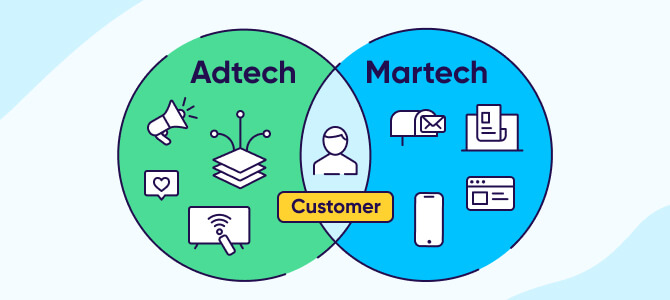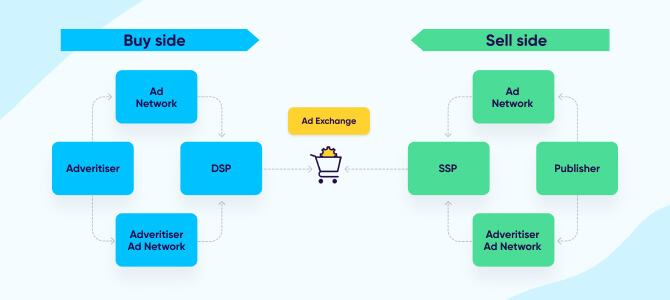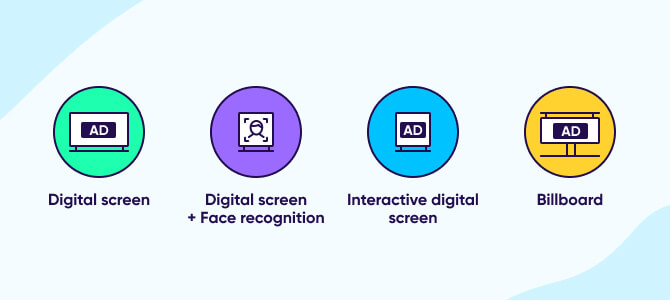What does AdTech stands for?
AdTech stands for “Advertising Technology”. It refers to the applications, platforms, and technologies that facilitate the purchase and sale of digital advertising.
Try searching for
AdTech is the market of technology providers and systems that make up the infrastructure of the online advertising industry.
AdTech, short for advertising technology, describes the software, tools, and systems that enable the buying and selling of digital advertising. AdTech allows advertisers to segment their audience, buy online ad space, serve up ads, and analyze their performance.
Buying and selling online advertising is a complex process, involving a network of advertisers (brands with content to promote), publishers (sites or apps with ad space to sell), and intermediaries. AdTech brings all these players together, providing the tools and platforms they need to negotiate and run campaigns.
It’s easy to confuse AdTech with MarTech (you guessed it: marketing technology), but there are several clear differences. MarTech is an umbrella term that covers all marketing technology products, from podcasting to content management to social media management platforms. You can think about AdTech as one branch of the big MarTech tree.

In-house marketing teams build a stack of MarTech platforms to help them communicate directly with leads and customers through email, social media, and their website. However, they may not play a hands-on role in the bidding or placement process for online advertising.
Instead, AdTech platforms, often directed by agencies, act as an intermediary to automate the ad-buying process and purchase audience impressions on behalf of a company.
| AdTech | MarTech | |
| Types of media supported | Paid online advertising | Paid online advertising, email marketing, SMS marketing, organic social media marketing, website publishing, SEO/SEM, organic video and audio content |
| Billing models | Cost of ad spend with a markup for commission | Flat subscription rates |
| Primary audience | Agencies and publishers | In-house marketers and agencies |
As online advertising has grown more complex, new tools and solutions have emerged to help advertisers manage and measure their campaigns. AdTech enables advertisers to run campaigns across channels, reach specific audiences, and analyze performance.
Here’s how AdTech can save you time and help you optimize digital campaigns.
Before AdTech, advertising managers had to manually research, select, and approve individual ad slots or placements. Now, brands can use automation, including AI and machine learning, to buy ad space and optimize campaigns based on real-time results.
In short, AdTech tools have made it easier to launch campaigns at scale without a large marketing team.
AdTech enables you to identify and reach a precise demographic, so you don’t waste your budget on general advertising that may or may not get to your ideal audience.
With AdTech, you can run omni-channel campaigns across devices. This works by recognizing a user based on their email address or cookies and matching them to other devices. Once a match is made in the network, ad networks can deliver re-engagement ads to give consumers multiple touchpoints. Cross-device tracking also enables better analytics, giving a fuller picture of the customer journey across devices.
Since AdTech can put campaign collateral out to bid in fractions of a second, you can launch a relevant campaign quickly, cutting out lengthy negotiation and placement. This brings you brand exposure, leads, and sales in a shorter time frame.
AdTech is essential for programmatic advertising — an automated ad-buying process that allows advertisers to buy access to precisely segmented audiences in real time. Programmatic has been dubbed the future of online advertising: Allied Market Research valued the programmatic advertising industry at $451 billion in 2021, and estimated it will grow a further 36% by 2031.

Here’s how AdTech makes it all possible:
All of the various intermediary parties and infrastructure used in programmatic advertising can be described as AdTech. We’ll explore them in more detail below.
To help you understand the complexities of AdTech, we’re going to unpack each of the different components that make up the AdTech ecosystem.
This is the part of an advertising agency that handles media planning and buying on behalf of clients. While brands can manage this directly through a DSP, ATDs offer expert guidance and agency buying power. Since they represent many clients, ATDs can work with multiple DSPs and negotiate in bulk to bring prices down.
A DSP is an automation platform that allows advertisers to bid for, buy, and place online advertising. It lets advertisers manage multiple ad exchange accounts through a single interface and make real-time changes based on campaign performance.
An SSP is a platform that manages a publisher’s ad inventory (the advertising space it has available) across ad exchanges. SSPs help publishers sell and manage their inventory at scale, earning revenue through real-time programmatic selling.
Publishers manage their inventory and earn revenue directly through ad networks. An ad network pools together bids and inventory from multiple exchanges to mediate sales between publishers and advertisers. Ad networks use algorithms to match advertisers with publishers that best fit their target audience.
An ad exchange is the technology that brings together the DSP and SSP sides of programmatic advertising in a neutral and transparent environment — similar to how the stock market connects buyers and sellers. It’s essentially an open pool of impressions that uses algorithms and machine learning to facilitate the bidding process in milliseconds.
An ad server is a platform that stores a campaign’s creative assets, selects which version to serve to the user, and collects data about the campaign performance.
A DMP is a centralized database that collects, stores, and deploys user data for online advertising. DMPs collect data from multiple sources to build a profile of a user’s demographics, interests, and behavior online.
The AdTech industry has grown and matured over the past twenty years, adding new technology and providers to make ad buying and selling faster and more efficient. During that time, the technology has adapted to reflect user preferences and an ever-changing regulatory environment.
Let’s take a look at the top trends and challenges shaping AdTech today, and how the landscape could evolve.
Programmatic advertising was largely built on cookies for matching IDs and re-engagement. However, consumers and regulators have mounted opposition to cookies and cross-device tracking due to privacy concerns. Ever adaptable, the AdTech industry has been developing alternative tracking methods that will still allow advertisers the data and analytics they crave — without compromising user security.
First, Apple implemented its app tracking transparency (ATT) framework, limiting the data available to advertisers. Next, Google announced it would eliminate its dependence on third-party cookies by 2024. Now, advertisers are braced for more change as Google, whose Android advertising is heavily based on Google Account ID (GAID) tracking, prepares to phase out GAID in favor of Privacy Sandbox.
Starting in 2024, Google will transition a portion of its users to Privacy Sandbox. Instead of recording and storing individual behavior, Privacy Sandbox pools users into anonymized groups with similar interests and serves them ad content based on their group demographics and interests. Google will seek input from advertisers and developers throughout the transition process, as it attempts to protect customers while giving advertisers the insights and impressions they want.

Streaming reigns supreme: 87% of U.S. households now own at least one connected TV (CTV) device. CTV devices include smart TVs, streaming boxes, and connected video consoles.
With streaming comes the opportunity for ad networks to deliver targeted video ads between shows, rather than linear ads for a general audience. CTV offers advertisers the chance to reach valuable audiences based on their interests, demographics, geography, and time of day.
In addition to targeted brand exposure, CTV offers powerful measurement options for advertisers. With cross-device data, advertisers can track CTV-to-mobile attribution to measure app installs and post-install events in a customer lifecycle. And in today’s economic climate, it’s more important than ever to understand the true impact of every marketing dollar spent.
Another fast-growing trend area in AdTech is in-game advertising. While mobile games soared in popularity during the pandemic, the buzz has died down and gaming app marketers are going all out to boost user acquisition. Global ad spend for gaming app installs totalled $26.7 billion in 2023.
Watching a video ad to get another life or a reward is just one example of how in-game advertising works. This partnership benefits both advertisers and publishers, though app developers need to balance in-game ads with user experience. AdTech facilitates bidding and delivers ad content to apps, just as it does to websites and video platforms.

If you saw a billboard near your office, chances are that an ad rep worked directly with the billboard owner to manually select each billboard placed in your city, street by street. AdTech can seriously streamline this slow, manual process.
Experts value the global DOOH (digital out-of-home) market at $18.8 billion and predict growth of 11.6% by 2030. With programmatic advertising, advertisers can launch a DOOH campaign at any moment. They can also target audiences with specific factors like weather or time of day for a powerful impact.
AdTech stands for “Advertising Technology”. It refers to the applications, platforms, and technologies that facilitate the purchase and sale of digital advertising.
AdTech focuses on the tools for buying and selling online advertising. It’s a subset of MarTech, which encompasses all marketing technologies including content management and social media platforms.
AdTech offers automation for efficient, scalable campaign management, optimized ad spending by targeting specific demographics, cross-device tracking for omni-channel campaigns, and speed in launching and analyzing advertising campaigns.
Programmatic advertising automates the buying and selling of digital ad space, allowing for real-time bidding and precise audience targeting. AdTech provides the technology and platforms that make this possible.
The AdTech ecosystem includes agency trading desks, demand-side platforms (DSPs), supply-side platforms (SSPs), ad networks, ad exchanges, ad servers, and data management platforms (DMPs), facilitating the complex processes of online advertising.
Privacy concerns and data security are leading trends, with the industry adapting to regulations and user preferences by developing alternatives to cookie-based tracking, such as Google’s Privacy Sandbox for grouped user data analysis. AdTech is also facilitating advertising on CTV, games, and digital-out-of-home.